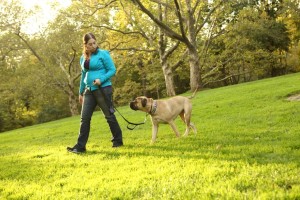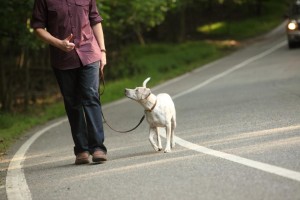A Stronger Connection Makes a Looser Leash
Pulling on leash is not only a safety issue, but it can also be a quality of life issue for you and your dog. Many dogs miss out on much-needed walks because their pulling makes it too difficult, embarrassing, or unsafe for their owner.

Whether huge (like this Mastiff) or little, a dog on a loose leash is a pleasure to stroll with.
As we discovered in Part 1 of this series, the good news is that your dog’s pulling can be reduced greatly and quickly just by choosing the right (gentle) equipment. Now, if you are ready to do some training work, we’ll show you how you can develop a loose-leash walker by using your voice, some directional changes and rewards for your dog.
In “trainers-speak”, the first part of this series taught you about management solutions (the quick fix) and now we’re going to explore modification (long-term behavior training).
It Starts with Attention
The biggest thing to remember when you are training loose-leash walking is NOT to follow your dog when she pulls. You have to stop the pulling from being a reward and make paying attention to you the more rewarding behavior. (Not an easy task with all of the interesting sights and scents outdoors.)
Prepare a bag (or treat pouch) of small, tasty treats and keep the bag in your pocket so you’re ready to reward throughout the walk. Alternatively, if your dog is crazy about a certain toy, you can use tug as a reward, but treats are generally the easiest to dispense repeatedly.
Step 1: Teach your dog to look at you when you make a unique sound, such as a whistle, a word, a kiss, or a tongue-click. This is done by making your chosen sound and then praising and treating your dog each time she turns to look at you in response. If the outdoors is too distracting for your dog, start training attention to the sound indoors.
Step 2: Once your dog is paying attention to this new sound reliably, you can use it on walks. When you can see she is about to pull, make that sound, then stop dead in your tracks. When your dog looks at you to “check in,” immediately praise and offer a treat, encouraging her to come over to you to get it. After giving the treat, walk in any direction other than the way the dog was pulling, giving more encouragement for your dog to follow. If she follows, give another reward!

Beautiful slack in this line comes as a direct result of the dog’s attention on the handler.
Step 3: Throughout your walks, continue to reward whenever the dog responds to your signal. Rewards can be given for: a) paying attention, and b) following you. Don’t always wait for your dog to start pulling before you give your signal. Give it whenever you are going to change direction, so you can “clue her in” and she doesn’t have to hit the end of the leash.
Step 4: Sometimes, give out rewards without any signals at all – just for the dog paying attention on her own, or for following you (instead of the other way around). Within a week of practice, you’ll have a dog who is very interested in checking in with you and following you. This will strengthen your connection, which makes for a much looser leash. That’s a win for both of you!
Note: This training works especially well with young puppies who have not yet learned that pulling is rewarding (gets you to follow). If your dog is a deeply established puller and/or you often run into distractions that cause her to ignore you no matter what you do, use the management techniques described in part 1 and consider working with a professional trainer in a private or group class setting. Working with a professional can do wonders for you and your dog.
If you have ever thought about becoming a professional yourself, talk to us at CATCH!






 Phone:
Phone:
My dog (1 yr old german sherherd) doesn’t pull on the leash, but her head is little away from my body, so she can’t really see which direction i’m taking and i often surprise her by changing my direction randomly, so she knows she needs to follow me and pay attention to me during walks. Also she is insecure in her walks…how do i get her to feel more confident…is this age related or breed related and will solve on its own. She is constantly looking around to make sure there is nothing wrong…How do i get her to trust me?
Kudos to you and your dog that she doesn’t pull on leash! Since she is showing stress or fear on walks, I would be careful of how many times you are surprising her with a quick change of direction, which might be leading to some of her walk insecurity. When dogs are pulling, surprising them with a direction change can be an effective technique in some cases, but a better technique that we often start with is to signal her first that you are changing direction (with a sound, for example) and then reward her when she follows you. Behaviors that get rewarded get repeated!
When you say she is constantly looking around to make sure nothing is wrong – that is an emotional issue first and foremost. The leash walking issue is a symptom of that – not an obedience problem. This is something that should be analyzed by a professional in person. We would recommend a pro who is experienced with behavior analysis and modification. That professional will most likely recommend that you focus on your dog feeling secure and comfortable in her walking environment first and foremost, then you can focus on obedience tasks like leash walking. Finally, when you ask, how can I get her to trust me – there is a good chance that trusting you has nothing to do with the issue – it sounds like there are things in the environment that may be making her stressed. This is common on busy streets, especially with dogs who did not get a lot of exposure to the sights and sounds of public places when they were in the early stages of puppyhood (the critical socialization period). If you feel she is not getting more comfortable from walking in the same environment every day, consider starting with walks in a quieter section of the neighborhood and short trips to her favorite places to help her gradually build confidence over time (keep in mind, generally with stress/fear improvements this means weeks and months, not days).
Thanks so much for your advice.